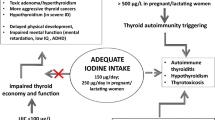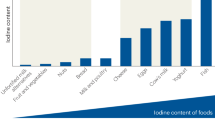Abstract
Although autoimmune hypothyroidism has generally been considered to be a disease that mainly develops because of genetic aberrations and for which adjustment of environment would bring about but slight risk modification, this understanding is increasingly appearing to be incorrect. We describe how iodine intake, smoking cessation and alcohol intake are all strong modifiers of risk that, combined, may influence risk by a factor of up to 30.
Unfortunately, promotion of an environment leading to substantial lowering of the risk of autoimmune hypothyroidism (i.e. improvement of dietary iodine deficiency, decrease or cessation of smoking, and moderate alcohol intake) is not incorporated within current public health promoting programs. Nevertheless, it is increasingly becoming evident that knowledge of the importance of these factors for disease development is likely to assist in the planning of health promotion programs, while it will surely also be of value in the care of individual patients.
Similar content being viewed by others
References
Laurberg P, Andersen S 2011 Prevention in endocrinology. In: Steward & Wass (eds) Oxford Textbook of Endocrinology and Diabetes 2nd ed. Oxford university Press; pp 8–13.
Brand OJ, Gough SCL, 2010 Genetics of thyroid autoimmunity and the role of the TSHR. Molecular and Cellular Endocrinol 322: 135–143.
Brix TH, Hegedüs L, 2012 Twin studies as a model for exploring the aetiology of autoimmune thyroid disease. Clin Endocrinol 76: 457–464.
Rothman KH, Greenland S, Poole C, Lash TL, 2008 Proportion of disease due to specific causes. In: Rothman KH, Greenland S & Lash TL (eds) Modern Epidemiology 3rd ed. Lippincott Williams & Wilkins; pp 13–15.
Laurberg P, Cerqueira C, Ovesen L, et al, 2010 Iodine intake as a determinant of thyroid disorders in populations. Best Practice & Research. Clin Endocrinol Metab 24: 13–27.
WHO, UNICEF & ICCIDD, 2007 assessment of iodine deficiency disorders and monitoring their elimination. A guide for programme managers 3rd ed. World Health Organization.
Gärtner R, 2009 Autoregulation of thyroid growth and function by iodine: independent regulation of the thyroid gland by iodocompounds. In: Preedy CR, Burrow GN & Watson TRW (eds). Comprehensive handbook of iodine: nutritional, biochemical and therapeutic aspects, Elsevier; pp 243–247.
Carlé A, Pedersen IB, Knudsen N, et al, 2011 Epidemiology of subtypes of hyperthyroidism in Denmark — a population based study. Eur J Endocrinol 164: 801–809.
Laurberg P, Jørgensen T, Perrild H, et al, 2006 The Danish Investigation on Iodine Intake and Thyroid Disease (DanThyr): status and perspectives. Eur J Endocrinol 155: 219–228.
Laurberg P, Pedersen IB, Carlé A et al, 2009 The U-shaped curve of iodine intake and thyroid disorders. In: Preedy VC, Burrow GN, Watson RR (eds). Comprehensive handbook on iodine: nutritional, endocrine and pathological aspects. Elsevier, pp; 449–455.
Carlé A, Laurberg P, Pedersen IB, et al, 2006 Epidemiology of subtypes of hypothyroidism in Denmark. Eur J Endocrinol 154: 21–28.
Pedersen KM, Laurberg P, Nøhr S, Jørgensen A, Andersen S, 1999 Iodine in drinking water varies more than 100 fold in Denmark. Importance for iodine content of infant formulas. Eur J Endocrinol 140: 400–403.
Pedersen IB, Laurberg P, Knudsen N, et al, 2007 An increased incidence of overt hypothyroidism after iodine fortification of salt in Denmark: a prospective population study. J Clin Endocrinol Metab 92: 3122–3127.
Pedersen IB, Knudsen N, Carlé A, et al, 2011 A cautious iodization programme bringing iodine intake to a low recommended level is associated with an increase in the prevalence of thyroid autoantibodies in the population. Clin Endocrinol 75: 120–126.
Rasmussen LB, Carlé A, Jørgensen T, et al, 2008 Iodine intake before and after mandatory iodization in Denmark: results from the Danish Investigation of Iodine Intake and Thyroid Diseases (DanThyr) study. Br J Nutr 100: 166–173.
Laurberg P, Pedersen KM, Hreidarsson A, Sigfusson N, Iversen E, Knudsen PR, 1998 Iodine intake and the pattern of thyroid disorders: a comparative epidemiological study of thyroid abnormalities in the elderly in Iceland and in Jutland, Denmark. J Clin Endocrinol Metab 83: 765–769.
Szabolcs I, Podoba J, Feldkamp J, et al, 1997 Comparative screening for thyroid disorders in old age in areas of iodine deficiency, long-term iodine prophylaxis and abundant iodine intake. Clin Endocrinol 47: 87–92.
Laurberg P, Pedersen IB, Pedersen KM, Vestergaard H, 1999 Low incidence rate of overt hypothyroidism compared with hyperthyroidism in an area with moderately low iodine intake. Thyroid 9: 33–38.
Teng X, Shan Z, Chen Y, et al, 2011 More than adequate iodine intake may increase subclinical hypothyroidism and autoimmune thyroiditis: a cross-sectional study based on two Chinese communities with different iodine intake levels. Eur J Endocrinol 164: 943–950.
Melse-Boonstra A, Gowachirapant S, Jaiswal N, Winichagoon P, Srinivasan K, Zimmermann MB, 2012 Iodine supplementation in pregnancy and its effect on child cognition. J Trace Elem Med Biol 26: 134–136.
Andersen S, Iversen F, Terpling S, Pedersen KM, Gustenhoff P, Laurberg P, 2009 More hypothyroidism and less hyperthyroidism with sufficient iodine nutrition compared to mild iodine deficiency — a comparative population-based study of older people. Maturitas 64: 126–131.
Andersen S, Pedersen KM, Iversen F, et al, 2008 Naturally occurring iodine in humic substances in drinking water in Denmark is bioavailable and determines population iodine intake. Br J Nutr 99: 319–325.
Laurberg P, 1994 Iodine intake — what are we aiming at? J Clin Endocrinol Metab 79: 17–19.
Mokdad AH, Marks JS, Stroup DF, Gerberding JL, 2004 Actual causes of death in the United States, 2000. JAMA 291: 1238–1245.
Carlé A, Pedersen IB, Knudsen N, et al, 2012 Smoking cessation is followed by a sharp but transient rise in the incidence of overt autoimmune hypothyroidism — A population-based case-control study. Clin Endocrinol 77: 764–772.
WHO, 2008 Report on the Global Tobacco Epidemic: The MPOWER package. World Health Organization.
Strieder TG, Prummel MF, Tijssen JG, Endert E, Wiersinga WM, 2003 Risk factors for and prevalence of thyroid disorders in a cross-sectional study among healthy female relatives of patients with autoimmune thyroid disease. Clin Endocrinol 59: 396–401.
Belin RM, Astor BC, Powe NR, Ladenson PW, 2004 Smoke exposure is associated with a lower prevalence of serum thyroid autoantibodies and thyrotropin concentration elevation and a higher prevalence of mild thyrotropin concentration suppression in the third National Health and Nutrition Examination Survey (NHANES III). J Clin Endocrinol Metab 89: 6077–6086.
Pedersen IB, Laurberg P, Knudsen N, et al, 2008 Smoking is negatively associated with the presence of thyroglobulin autoantibody and to a lesser degree with thyroid peroxidase autoantibody in serum: a population study. Eur J Endocrinol 158: 367–373.
Effraimidis G, Tijssen JG, Wiersinga WM, 2009 Discontinuation of smoking increases the risk for developing thyroid peroxidase antibodies and/or thyroglobulin antibodies: a prospective study. J Clin Endocrinol Metab 94: 1324–1328.
Knudsen N, Bulow I, Laurberg P, Perrild H, Ovesen L, Jørgensen T, 2002 High occurrence of thyroid multinodularity and low occurrence of subclinical hypothyroidism among tobacco smokers in a large population study. J Endocrinol 175: 571–576.
Vestergaard P, 2002 Smoking and thyroid disorders — a meta-analysis. Eur J Endocrinol 146: 153–161.
Flegal KM, Troiano RP, Pamuk ER, Kuczmarski RJ, Campbell SM, 1995 The influence of smoking cessation on the prevalence of overweight in the United States. N Engl J Msed 333: 1165–1170.
Yeh HC, Duncan BB, Schmidt MI, Wang NY, Brancati FL, 2010 Smoking, smoking cessation, and risk for type 2 diabetes mellitus: a cohort study. Ann Intern Med 152: 10–17.
Oba S, Noda M, Waki K, et al, 2012 Smoking cessation increases short-term risk of type 2 diabetes irrespective of weight gain: The Japan Public Health Center-Based Prospective Study. PLoS One 7: e17061.
Laurberg P, Andersen S, Knudsen N, Ovesen L, Nøhr SB, Pedersen IB, 2002 Thiocyanate in food and iodine in milk: from domestic animal feeding to improved understanding of cretinism. Thyroid 12: 897–902.
Laurberg P, Nøhr SB, Pedersen KM, Fuglsang E, 2004 Iodine nutrition in breast-fed infants is impaired by maternal smoking. J Clin Endocrinol Metab 89: 181–187.
Ditzel J, Lervang HH, 2010 Lifestyle diseases and cardiovascular risk factors are interrelated to deficiencies of major substrates in ATP synthesis. Vasc Health Risk Manag 6: 829–836.
Caturegli P, De Remigis A, Ferlito M, et al, 2012 Anatabine ameliorates experimental autoimmune thyroiditis. Endocrinology 153: 4580–4587.
Stampfer MJ, Colditz GA, Willett WC, Speizer FE, Hennekens CH, 1988 A prospective study of moderate alcohol consumption and the risk of coronary disease and stroke in women. N Engl J Med 319: 267–273.
Cohen S, Tyrrell DA, Russell MA, Jarvis MJ, Smith AP, 1993 Smoking, alcohol consumption, and susceptibility to the common cold. Am J Pub Health 83: 1277–1283.
Simon JA, Grady D, Snabes MC, Fong J, Hunninghake DB, 1998 Ascorbic acid supplement use and the prevalence of gallbladder disease Heart & Estrogen-Progestin Replacement Study (HERS) Research Group. J Clin Epidemiol 51: 257–265.
Curhan GC, Willett WC, Rimm EB, Spiegelman D, Stampfer MJ, 1996 Prospective study of beverage use and the risk of kidney stones. Am J Epidemiol 143: 240–247.
Obisesan TO, Hirsch R, Kosoko O, Carlson L, Parrott M, 1998 Moderate wine consumption is associated with decreased odds of developing age-related macular degeneration in NHANES-1. J Am Geriatr Soc 46: 1–7.
Orgogozo JM, Dartigues JF, Lafont S, et al, 1997 Wine consumption and dementia in the elderly: a prospective community study in the Bordeaux area. Rev Neurol 153: 185–192.
Lieberoth S, Backer V, Kyvik KO, et al, 2012 Intake of alcohol and risk of adult-onset asthma. Resp Med 106: 184–188.
Carle A, Pedersen IB, Knudsen N, et al, 2012 Moderate alcohol consumption may protect against overt autoimmune hypothyroidism — a population-based case-control study. Eur J Endocrinol 167: 483–490.
Effraimidis G, Tijssen JGP, Wiersmga WM, 2012 Alcohol consumption as a risk factor for autoimmune thyroid disease: a prospective study. Eur Thyroid J 1: 99–104.
Knudsen N, Pedersen IB, Laurberg P, Perrild H, Ovesen L, Jorgensen T, 2001 Alcohol consumption is associated with reduced prevalence of goitre and solitary thyroid nodules. Clin Endocrinol 55: 41–46.
Hegedus L, Rasmussen N, Ravn V, Kastrup J, Krogsgaard K, Aldershvile J, 1988 Independent effects of liver disease and chronic alcoholism on thyroid function and size: the possibility of a toxic effect of alcohol on the thyroid gland. Metabolism 37: 229–233.
Wang J, Pan HF, Ye DQ, Su H, Li XP, 2008 Moderate alcohol drinking might be protective for systemic lupus erythematosus: a systematic review and meta-analysis. Clin Rheum 27: 1557–1563.
Di Giuseppe D, Alfredsson L, Bottai M, Askling J, Wolk A, 2012 Long term alcohol intake and risk of rheumatoid arthritis in women: a population based cohort study. BMJ 345: e4230.
Rasouli B, Ahlbom A, Andersson T, et al, 2012 Alcohol consumption is associated with reduced risk of type 2 diabetes and autoimmune diabetes in adults: results from the Nord-Trondelag health study. Diabet Med 30: 56–64.
Mandrekar P, Catalano D, Dolganiuc A, Kodys K, Szabo G, 2004 Inhibition of myeloid dendritic cell accessory cell function and induction of T cell energy by alcohol correlates with decreased IL-12 production. J Immunol 173: 3398–3407.
Verma S, Alexander CM, Carlson MJ, Tygrett LT, Waldschmidt TJ, 2008 B-cell studies in chronic ethanol mice. Methods Mol Biol 447: 295–323.
Fan J, Edsen-Moore MR, Turner LE, et al, 2011 Mechanisms by which chronic ethanol feeding limits the ability of dendritic cells to stimulate T-cell proliferation. Alcohol Clin Exp Res 35: 47–59.
Hollowell JG, Staehling NW, Flanders WD, et al, 2002 Serum TSH, T(4), and thyroid antibodies in the United States population (1988 to 1994): National Health and Nutrition Examination Survey (NHANES III). J Clin Endocrinol Metab 87: 489–499.
Author information
Authors and Affiliations
Corresponding author
Additional information
According to Greek mythology, the sea-monsters Scylla and Charybdis were on either side of a strait so narrow that sailors attempting to avoid one monster would come dangerously close to the other.
Rights and permissions
About this article
Cite this article
Laurberg, P., Andersen, S., Pedersen, I.B. et al. Prevention of autoimmune hypothyroidism by modifying iodine intake and the use of tobacco and alcohol is manoeuvring between Scylla and Charybdis. Hormones 12, 30–38 (2013). https://doi.org/10.1007/BF03401284
Received:
Accepted:
Published:
Issue Date:
DOI: https://doi.org/10.1007/BF03401284




